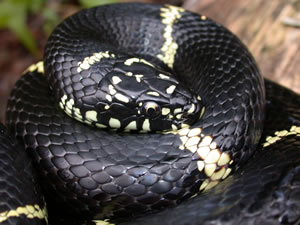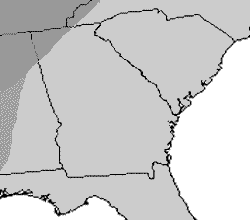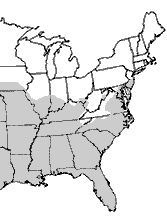Eastern Kingsnake (Lampropeltis getula)



Photos by J. D. Wilson unless otherwise noted
| Description: Description: Eastern kingsnakes are large — 36 – 48 in (90-122 cm) — shiny-black, smooth-scaled snakes with white or yellow chain-link bands that cross the back and connect along the sides. Because of this pattern this species is also referred to as the chain kingsnake. Generally, individuals from the Coastal Plain have wide bands while those from the mountains may have very thin bands or be nearly completely black. Eastern kingsnakes have a short stout head and small beady eyes. They have an undivided anal plate. Kingsnakes have one of the largest geographic ranges of any North American snake species and their coloration is variable across their range. Although kingsnakes from most areas of Georgia and South Carolina are of the Eastern subspecies (Lampropeltis getula getula), two other subspecies approach our region. The black kingsnake (L. g. nigra), which lacks yellow or white crossbands, is found in the north-central United States, including mountainous regions of northwestern Georgia. As its name implies, the speckled kingsnake (L. g. holbrooki), exhibits dark background coloration speckled with yellow or white. The speckled kingsnake is characteristic of the Gulf Coast from central Alabama to Texas. Partially speckled color variants are also found in the Apalachicola region of the Florida panhandle and on the Outer Banks of North Carolina.
Distribution and Habitat: Eastern kingsnakes are found throughout the eastern United States north to New Jersey . They are found in all areas of Georgia and South Carolina. They thrive in many habitats including hardwood and pine forests, bottomlands and swamps, hammocks, tidal wetlands, and even farmlands and suburban areas. This species is strongly terrestrial, but inhabits areas close to water such as stream banks and swamp borders. They are quite secretive and are frequently found under boards, tin or other cover objects. Habits: In our region kingsnakes are active almost exclusively by day but are most active in the morning during the summer. They are strong constrictors and consume a variety of prey including snakes, lizards, rodents, birds, and especially turtle eggs. Kingsnakes are resistant to the venom of pit-vipers and they readily eat copperheads, cottonmouths, and rattlesnakes. Although they frequently rattle their tail, release musk, and bite upon capture, they generally tame quickly and are often kept as pets. This species mates in the spring and males bite the neck of females while mating. Females lay 3-24 eggs under debris or in rotting logs in early summer and eggs hatch in August-September. Conservation Status: Eastern kingsnakes are protected throughout the state of Georgia, but not in other parts of their range. However, concern has been expressed by some herpetologists that this species is declining in some areas of the Coastal Plain and in Florida. Although kingsnakes remain common in many regions, in some regions where they were once abundant they have recently nearly disappeared. The causes of these declines are unknown but habitat loss and degradation, imported fire ants, or diseases are potential causes. One formerly healthy and large kingsnake population on the Savannah River Site has been documented to have virtually disappeared in the last 20 years. Pertinent References Winne, C. T., J. D. Willson, B. D. Todd, K. M. Andrews, and J. W. Gibbons. In press. Enigmatic decline of a protected population of eastern kingsnakes, Lampropeltis getula. Copiea 2007(3): 507-519. Krysko, K. L. 2002. Seasonal activity of the Florida kingsnake Lampropeltis getula floridana (Serpentes: Colubridae) in southern Florida. American Midland Naturalist 148: 102-114. Account author: Kimberly Andrews and J.D. Willson |
